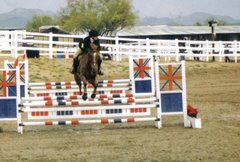The following is a list of materials used and what they represent
- Hedger handles- Humerus, radius and ulna

- Popcicle sticks- elbow joint (trochlea),myosin
- Red Yarn- biceps brachii
- Pipe cleaners- cross bridges of myosin (blue), Actin (white), Axons (white), dendrite (white), T tubules (green)
- Styrofoam balls- different neurons
- Electrical tape- myelin sheath
- Hot glue- sensory receptors
- Wire- Z lines
- Clear tubing- sarcolemma, myofibril (with red lines)
- Markers and paint- used to add color to myofibril and axon terminals

This first picture is of the bone structure showing how the humerus connects to the radius an ulna by the elbo joint. This is a hinge joint and can only bend one way. The joint is represented by a roll of popsicle sticks. They represent the trochlea and capitulum .
The second picture shows the red yarn representing the biceps  brachii. It is attatched to the top of the humerus and scapula (origin) and also to the radius (insertion).
brachii. It is attatched to the top of the humerus and scapula (origin) and also to the radius (insertion).
The third and fourth picture show the sarcomeres in a myofibril when they are relaxed and also when they are contracted. The sarcomeres contain actin and m yosin. When the im
yosin. When the im pulse travels down the t tubules (fifth picture), calcium is released into the sarcoplasmic reticulum causing the sarcomeres to contract (actin slides past myosin) and shorten.
pulse travels down the t tubules (fifth picture), calcium is released into the sarcoplasmic reticulum causing the sarcomeres to contract (actin slides past myosin) and shorten.
 d myofibril with z lines.
d myofibril with z lines.The last picture is of the different types of neurons, their axons, dendrites, and m
 yelin sheath. The neurons are responsible for taking impulses from the CNS, summing up these impulses, distributing them to and effector to carry out the response.
yelin sheath. The neurons are responsible for taking impulses from the CNS, summing up these impulses, distributing them to and effector to carry out the response.In conclusion this model shows the different units involved in muscle movement from the neurons all the way up to bones and muscles. This model was a good learning tool because when I actually had to make these aspects I had to think about their functions and understand how they worked individually and then how they all tied together.

1 comment:
Jaima, stellar, really perfect work on this unit. I liked your model, your compendiums are very complete and nice work on the online labs. Keep it up and just one more to go!
LF
Post a Comment